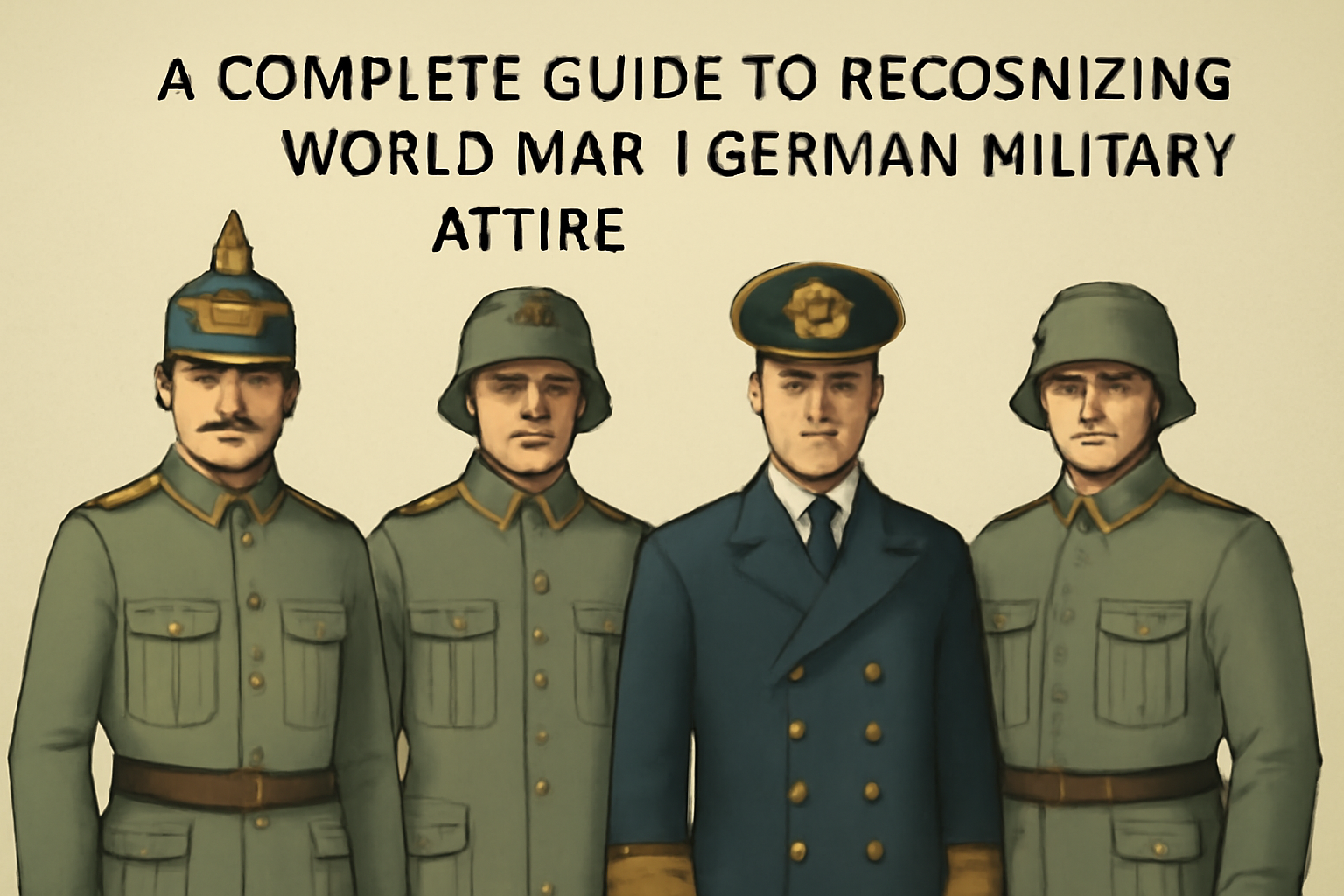
WW1 German Uniform Identification: A Complete Guide to Recognizing World War 1 German Military Attire
Published on May 28, 2025
WW1 German Uniform Identification: A Complete Guide to Recognizing World War 1 German Military Attire
World War 1 marked a pivotal era in military history, and German uniforms from this period are highly sought after by collectors and enthusiasts worldwide. Understanding the nuances of these uniforms is essential not only for accurate identification but also for appreciating the history and evolution of military apparel in the early 20th century. In this article, we’ll delve into the details of WW1 German uniforms, covering the iconic Prussian army uniforms, navy attire, and later developments such as the West German army uniform.
Understanding the Basics of WW1 German Uniforms
The German Empire, during WW1, was composed of various military branches, each with its unique uniform styles and insignias. The main forces included the Imperial German Army (Deutsches Heer), the Imperial German Navy (Kaiserliche Marine), and the air service (Luftstreitkräfte).
German uniforms from this era were distinct for their functionality, style, and symbolic significance. They reflected rank, regiment, and sometimes even the soldier’s geographic origin within the empire.
Prussian Army Uniforms 1870: The Roots of German Military Style
Before WW1, the Prussian army laid the groundwork for German military fashion. The Prussian army uniforms of 1870 were influential and became a prototype for subsequent German uniforms.
- Color and Fabric: The traditional Prussian uniforms were typically dark blue with red piping and brass buttons.
- Pickelhaube Helmet: One of the most recognizable features was the spiked helmet, known as the Pickelhaube. This helmet remained a symbol of Prussian and early German military might.
- Rank Insignia: Shoulder boards and collar patches were used to denote ranks.
- Royal Army Jacket: The royal army jacket was a stylish, tailored piece that combined practicality with elegance, often worn during ceremonial duties.
This heritage greatly influenced the WW1 German army uniform design.
WW1 German Army Uniforms: Key Features
By the onset of World War 1, German military uniforms had evolved to meet the demands of modern warfare:
- Field Grey Color: The iconic field grey (Feldgrau) replaced the traditional blue, offering better camouflage.
- Tunic Design: The tunic featured a stand-up collar and pleated pockets. Buttons were often made of brass or steel.
- Insignia and Badges: Shoulder boards indicated rank and unit, while collar patches identified specific regiments.
- Headgear: The Pickelhaube was initially used, but by mid-war, the steel helmet (Stahlhelm) became standard due to its superior protection.
- D Day Uniform Connection: Although the D Day uniform is more associated with WWII Allied forces, many collectors compare WW1 German uniforms with those later worn by both Axis and Allied troops to understand the evolution of military gear.
World War I Navy Uniforms: The Imperial German Navy
The Imperial German Navy (Kaiserliche Marine) had distinct uniforms different from the army:
- Color: Navy uniforms were predominantly dark blue.
- Double-Breasted Jackets: Officers typically wore double-breasted jackets with gold buttons.
- Rank Insignia: Stripes on cuffs and shoulder boards indicated rank.
- Caps: The navy cap was a signature piece, often embroidered with the Imperial eagle and a cockade.
Collectors interested in naval history often seek these uniforms due to their elegant design and historical significance.
West German Army Uniform: Post-WW1 Evolution
Although the West German army uniform is technically post-WW1, its roots can be traced back to the traditions established during WW1 and WWII:
- Cold War Era: The West German army (Bundeswehr) uniforms reflected modern materials and designs but retained some traditional elements like shoulder insignias and certain cuts.
- Comparison with WW1 Uniforms: Studying the West German army uniform can offer insights into how military clothing adapted to new technologies and changing warfare tactics.
Why Collectors Value WW1 German Uniforms
- Historical Significance: Each uniform tells a story about Germany’s military history and the soldiers who wore them.
- Craftsmanship: The quality of materials and tailoring was exceptional.
- Symbolism: Uniforms symbolize ranks, units, and sometimes battles or campaigns.
- Rarity: Authentic WW1 German uniforms have become rarer over time, increasing their value.
Tips for Identifying Authentic WW1 German Uniforms
- Check the Fabric and Color: Original field grey is different from modern reproductions.
- Look for Markings: Manufacturer stamps, dates, and unit markings can authenticate the uniform.
- Study Insignia Details: Rank and regiment insignia help pinpoint the exact type of uniform.
- Helmet Styles: Early war Pickelhaube helmets differ from later Stahlhelms.
- Consult Experts: When in doubt, professional appraisers or military historians can provide verification.
Related Uniforms and Keywords for Enthusiasts
- Royal Army Jacket: Not exclusive to Germany, but similar styles appear in European military attire.
- D Day Uniform: While primarily Allied, comparisons help understand uniform evolution.
- WWI US Navy Uniform: A contrasting style, interesting for collectors focusing on naval history.
- West German Army Uniform: For those interested in post-WW1 developments.
Conclusion
Identifying WW1 German uniforms involves understanding a rich history of military fashion, practical design, and symbolic importance. From the iconic Prussian army uniforms of 1870 to the distinct styles of the Imperial German Navy and the evolution into West German army attire, each piece offers a window into a bygone era. Whether you’re a collector, reenactor, or history enthusiast, learning to recognize these uniforms enhances your appreciation for the complexity and heritage of military history.
For more detailed articles and resources on WW1 German uniforms and other military attire, explore the other sections on Paddelaters.com and deepen your knowledge of historical military fashion.
